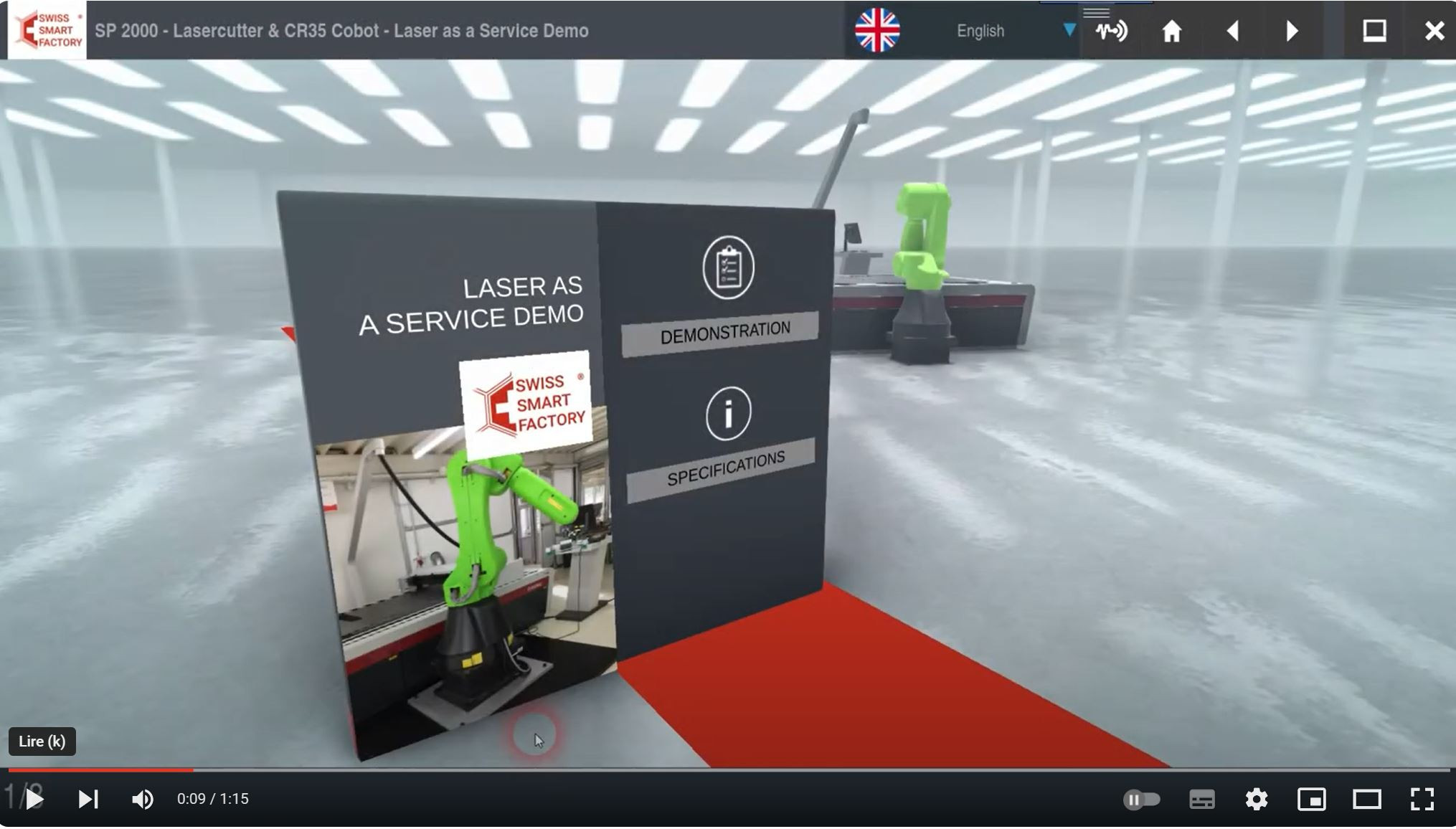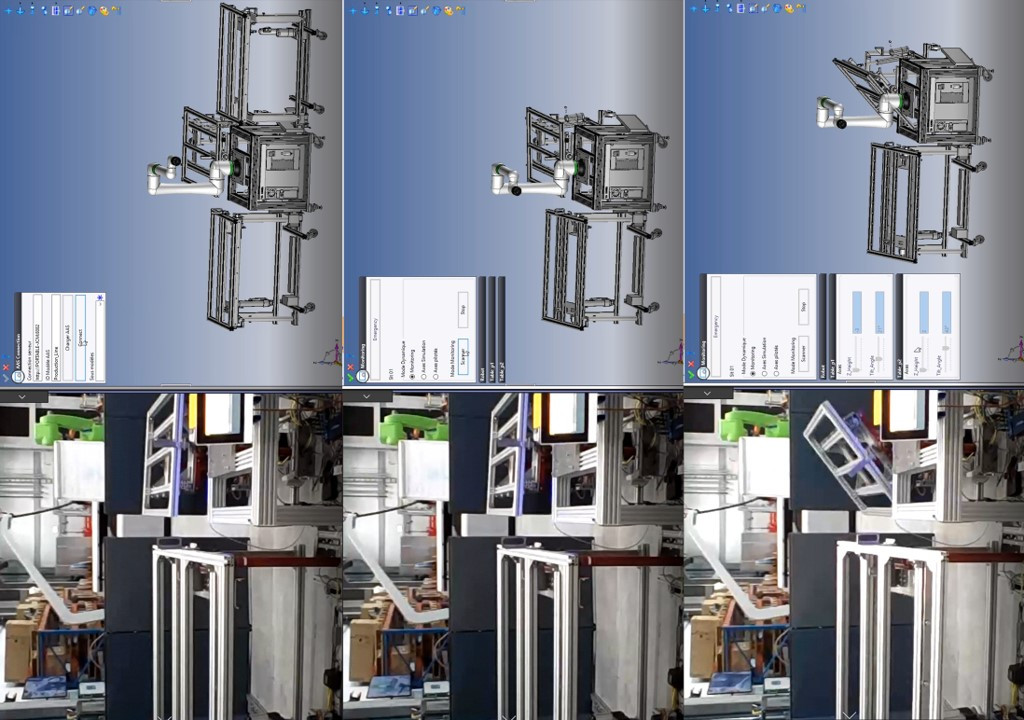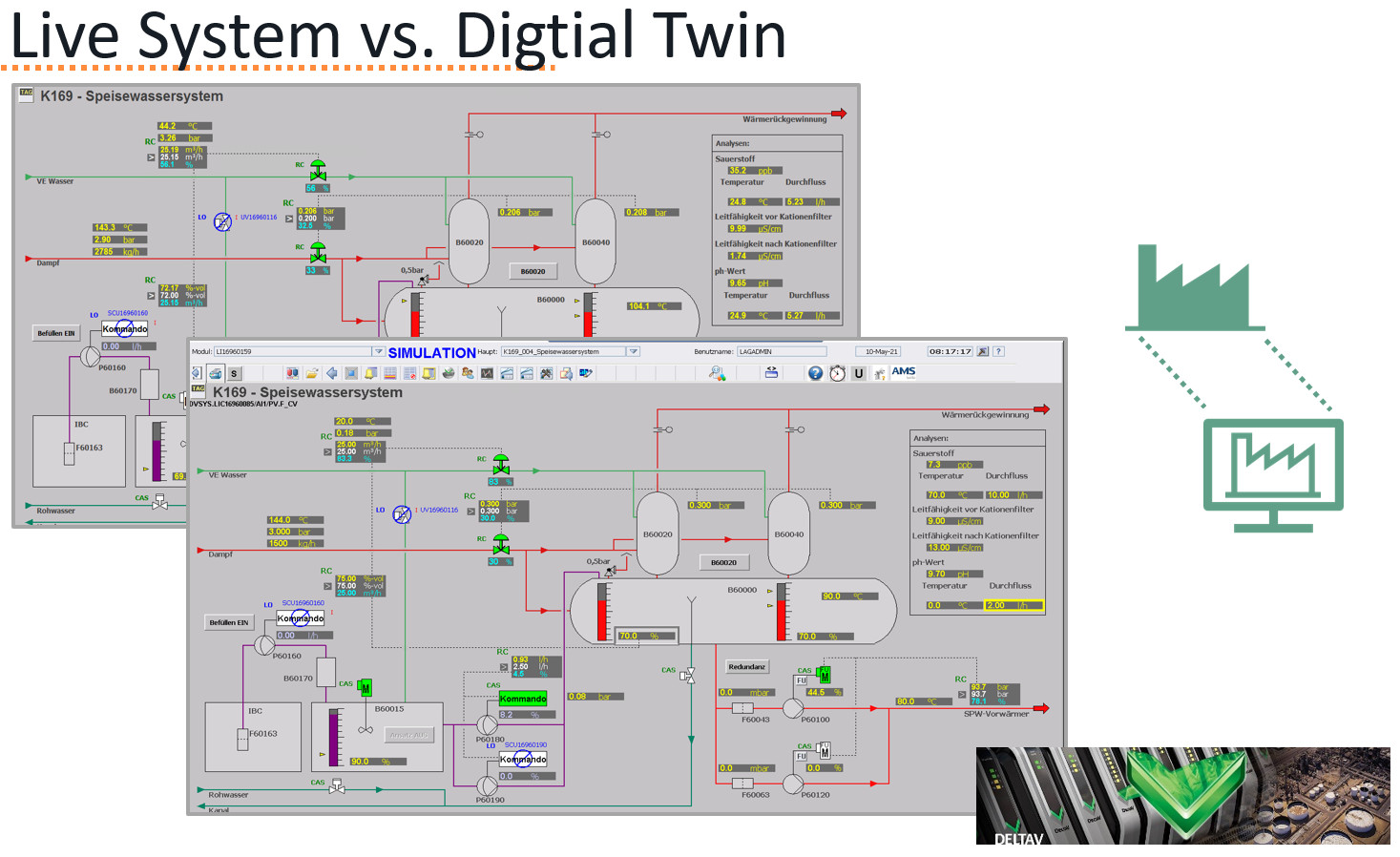Recent advances in sensor and edge data processing systems have created new opportunities for the creation of accurate digital representations (or digital twins) of physical processes (e.g., manufacturing processes). At the same time, the induced modeling tasks have grown in scale and computational needs, e.g., going from small scale control system technologies applied on a single machine or a single process step to modeling and supervising complete industrial process lines. Naturally, and due to the recent successes of deep-learning and neural networks, data-based modeling techniques and predictive data analytics have drawn significant attention as an alternative to physics-based modeling techniques. However, the implementation, integration and acceptance of data-based methods brings up several new challenges, namely a) integrating systems of different nature and modeling granularity, b) integrating expert/domain knowledge, c) handling unforeseen or new scenarios and operating conditions and d) the need for human-machine interaction. In this presentation, we will review some of the most prominent challenges in the implementation of data-based modeling techniques for predictive data analytics and optimization in process industry and discuss current practices for tackling them. The presentation of these challenges will be organized in three thematic areas, namely a) virtual sensors, b) industrial reactive optimization, and c) hierarchical predictive modeling and optimization.
The implementation of data-based predictive analytics and digital twins faces challenges with respect to a) domain generalization (i.e., the ability of the model to perform equally well in different scenarios and operating conditions), b) complexity in decision support and reaction speed, c) human-machine interaction and explainability.
In this presentation, we will discuss these challenges in the context
of real-world industrial use-cases and discuss some of the current
practices for tackling them. The presentation of these challenges will
be organized in three thematic areas, namely a) virtual sensors, b) industrial reactive optimization, and c) hierarchical predictive modeling and optimization.
Virtual Sensors
In
recent years, sensor and edge processing technologies allow for almost
real-time monitoring of complex industrial processes. However, there
might still be phenomena and process details that cannot accurately be
monitored and regulated without including a form of prediction or
simulation of the process evolution. An example is demonstrated in
Figure 1 of the metal bending process. A set of sensors can monitor the
process, however the operator requires a simulation of the upcoming
evolution of the process in order to proactively regulate the applied
force and achieve the desired final angle. The problem becomes even more
challenging when we consider the case of different types of material
and different scenarios (e.g., machine tools and configurations). We
will present a framework for combining physical-based modeling
techniques with machine-learning techniques in order to improve the
prediction accuracy of the process evolution. Furthermore, we will
present a methodology for domain generalization into multiple scenarios.

Figure 1. Metal bending process and comparison between physics-based modeling and hybrid modeling.
Industrial Reactive Optimization
Industrial
processes could be highly complex due to the increased variability in
the input and configuration parameters as well as the influence of
unpredictable exogenous factors. In certain cases operators need to
continuously monitor the sensor data and react within a few seconds by
re-configuring the process parameters. Although operators might be
quite experienced in regulating the process, often support is required
from sensors, predictive models and digital twins to allow
for more informative and quick decisions. In this part of the
presentation, we discuss challenges and best practices in establishing a
data processing pipeline for providing near real-time suggestions to the operator.

Figure 2. Big Data Management and Monitoring of a Lime Calcination Process.
Hierarchical Predictive Modeling and Optimization
The
traditional paradigm of a digital twin usually considers specific parts
of the process or process steps. When there is a need for simulating,
monitoring or predicting complex processes of possibly heterogeneous
systems or multiple process steps, several new challenges emerge.
Specifically, monitoring of the overall process by the operators becomes
a great challenge given the potentially large amount of sensor data
from different parts of the process, and the lack of better and more
human-readable interpretation of the process operating conditions. In
this part of the presentation, we present some techniques for providing a
more human interpretable and understandable monitoring of the process
through causal inference modeling techniques.

Figure 3. Generalized Hidden Markov Models for supervisory process analysis.
<p style="margin:0in;line-height:85%">
</p>
<p style="margin:0in;line-height:85%"><b><span style="font-size:10.0pt;
line-height:85%;font-family:Roboto;color:black;mso-themecolor:text1;background:
white">Virtual Sensors</span></b></p>
<p style="margin:0in;line-height:85%"><span style="font-size:10.0pt;line-height:
85%;font-family:Roboto;mso-fareast-font-family:"Times New Roman";mso-fareast-theme-font:
minor-fareast;mso-bidi-font-family:Arial;color:black;mso-themecolor:text1;
letter-spacing:-.1pt;mso-font-kerning:12.0pt"> </span></p>
<p style="margin-top:0in;margin-right:0in;margin-bottom:0in;margin-left:.5in;
text-indent:-.25in;line-height:85%;mso-list:l0 level1 lfo1"><span style="font-size:10.0pt;line-height:85%;font-family:Symbol;mso-fareast-font-family:
Symbol;mso-bidi-font-family:Symbol;color:black;mso-themecolor:text1;letter-spacing:
-.1pt;mso-font-kerning:12.0pt"><span style="mso-list:Ignore">·<span style="font:7.0pt "Times New Roman"">
</span></span></span><span style="font-size:10.0pt;line-height:85%;
font-family:Roboto;color:black;mso-themecolor:text1;mso-ligatures:none">T.
Grubinger, G. Chasparis, and T. Natschläger, “</span><span style="font-size:
10.0pt;line-height:85%;font-family:Roboto;color:#2E74B5;mso-themecolor:accent5;
mso-themeshade:191;mso-ligatures:none"><a href="https://www.digital-twin-atlas.com/knowledge-hub/article/8/10.1016/j.enbuild.2016.12.074"><span style="color:#2E74B5;mso-themecolor:accent5;mso-themeshade:191">Generalized
online transfer learning for climate control in residential buildings</span></a></span><span style="font-size:10.0pt;line-height:85%;font-family:Roboto;color:black;
mso-themecolor:text1;mso-ligatures:none">,” <i>Energy and Buildings</i>, vol.
139, pp. 63–71, Mar. 2017.</span><span style="font-size:10.0pt;line-height:
85%;font-family:Roboto;mso-fareast-font-family:"Times New Roman";mso-fareast-theme-font:
minor-fareast;mso-bidi-font-family:Arial;color:black;mso-themecolor:text1;
letter-spacing:-.1pt;mso-font-kerning:12.0pt"></span></p>
<p style="margin-top:0in;margin-right:0in;margin-bottom:0in;margin-left:.5in;
text-indent:-.25in;line-height:85%;mso-list:l0 level1 lfo1"><span style="font-size:10.0pt;line-height:85%;font-family:Symbol;mso-fareast-font-family:
Symbol;mso-bidi-font-family:Symbol;color:black;mso-themecolor:text1;letter-spacing:
-.1pt;mso-font-kerning:12.0pt"><span style="mso-list:Ignore">·<span style="font:7.0pt "Times New Roman"">
</span></span></span><span style="font-size:10.0pt;line-height:85%;
font-family:Roboto;mso-bidi-font-family:Arial;color:black;mso-themecolor:text1;
letter-spacing:-.1pt">W. Zellinger, T. Grubinger, M. Zwick, "</span><span style="font-size:10.0pt;line-height:85%;font-family:Roboto;mso-bidi-font-family:
Arial;color:#2E74B5;mso-themecolor:accent5;mso-themeshade:191;letter-spacing:
-.1pt"><a href="https://doi.org/10.1007/s10845-019-01499-4"><span style="color:#2E74B5;mso-themecolor:accent5;mso-themeshade:191">Multi-source
transfer learning of time series in cyclical manufacturing</span></a></span><span style="font-size:10.0pt;line-height:85%;font-family:Roboto;mso-bidi-font-family:
Arial;color:black;mso-themecolor:text1;letter-spacing:-.1pt">," <i>J Intell
Manuf </i>31, pp. 777-787, 2020.</span><span style="font-size:10.0pt;
line-height:85%;font-family:Roboto;mso-fareast-font-family:"Times New Roman";
mso-fareast-theme-font:minor-fareast;mso-bidi-font-family:Arial;color:black;
mso-themecolor:text1;letter-spacing:-.1pt;mso-font-kerning:12.0pt"></span></p>
<p style="margin-top:0in;margin-right:0in;margin-bottom:0in;margin-left:.5in;
text-indent:-.25in;line-height:85%;mso-list:l0 level1 lfo1"><span style="font-size:10.0pt;line-height:85%;font-family:Symbol;mso-fareast-font-family:
Symbol;mso-bidi-font-family:Symbol;color:black;mso-themecolor:text1;letter-spacing:
-.1pt;mso-font-kerning:12.0pt"><span style="mso-list:Ignore">·<span style="font:7.0pt "Times New Roman"">
</span></span></span><span style="font-size:10.0pt;line-height:85%;
font-family:Roboto;color:black;mso-themecolor:text1;mso-ligatures:none">S.
Luftensteiner and M. Zwick, “</span><span style="font-size:10.0pt;line-height:
85%;font-family:Roboto;color:#2E74B5;mso-themecolor:accent5;mso-themeshade:
191;mso-ligatures:none"><a href="http://www.thinkmind.org/index.php?view=article&articleid=dbkda_2021_1_60_50033"><span style="color:#2E74B5;mso-themecolor:accent5;mso-themeshade:191">A Framework for
Improving Offline Learning Models with Online Data</span></a></span><span style="font-size:10.0pt;line-height:85%;font-family:Roboto;color:black;
mso-themecolor:text1;mso-ligatures:none">,” presented at the <i>DBKDA 2021, The
Thirteenth International Conference on Advances in Databases, Knowledge, and
Data Applications</i>, May 2021, pp. 32–37. </span><span style="font-size:10.0pt;line-height:85%;font-family:Roboto;mso-fareast-font-family:
"Times New Roman";mso-fareast-theme-font:minor-fareast;mso-bidi-font-family:
Arial;color:black;mso-themecolor:text1;letter-spacing:-.1pt;mso-font-kerning:
12.0pt"></span></p>
<span style="font-size:10.0pt;line-height:85%;
font-family:Roboto;color:black;mso-themecolor:text1;mso-ligatures:none"></span><span style="font-size:10.0pt;line-height:85%;font-family:Roboto;mso-fareast-font-family:
"Times New Roman";mso-fareast-theme-font:minor-fareast;mso-bidi-font-family:
Arial;color:black;mso-themecolor:text1;letter-spacing:-.1pt;mso-font-kerning:
12.0pt"></span>
<p style="margin:0in;line-height:85%"><span style="font-size:10.0pt;line-height:
85%;font-family:Roboto;mso-bidi-font-family:Arial;color:black;mso-themecolor:
text1"><br></span></p>
<p style="margin:0in;line-height:85%"><b><span style="font-size:10.0pt;
line-height:85%;font-family:Roboto;mso-bidi-font-family:Arial;color:black;
mso-themecolor:text1">Industrial Reactive Optimization</span></b></p>
<p style="margin:0in;line-height:85%"><span style="font-size:10.0pt;line-height:
85%;font-family:Roboto;mso-bidi-font-family:Arial;color:black;mso-themecolor:
text1"> </span></p>
<p style="margin-top:0in;margin-right:0in;margin-bottom:0in;margin-left:.5in;
text-indent:-.25in;line-height:85%;mso-list:l0 level1 lfo1"><span style="font-size:10.0pt;line-height:85%;font-family:Symbol;mso-fareast-font-family:
Symbol;mso-bidi-font-family:Symbol;color:black;mso-themecolor:text1;letter-spacing:
-.1pt;mso-font-kerning:12.0pt"><span style="mso-list:Ignore">·<span style="font:7.0pt "Times New Roman"">
</span></span></span><span style="font-size:10.0pt;line-height:85%;
font-family:Roboto;color:black;mso-themecolor:text1;background:white">S.
Luftensteiner, M. Mayr, <strong><span style="font-family:Roboto;font-weight:
normal">G. Chasparis</span></strong><span style="font-variant-ligatures: normal;
font-variant-caps: normal;orphans: 2;text-align:start;widows: 2;-webkit-text-stroke-width: 0px;
text-decoration-thickness: initial;text-decoration-style: initial;text-decoration-color: initial;
float:none;word-spacing:0px">, M. Pichler, “</span></span><span style="font-size:10.0pt;line-height:85%;font-family:Roboto;color:#0070C0"><a href="https://doi.org/10.3389/fceng.2021.665545" style="box-sizing: border-box;
transition: color 0.1s ease-in-out 0s, background-color 0.1s ease-in-out 0s;
font-variant-ligatures: normal;font-variant-caps: normal;orphans: 2;text-align:
start;widows: 2;-webkit-text-stroke-width: 0px;word-spacing:0px"><span style="color:#0070C0;background:white">A Versatile Usable Big Data
Infrastructure for Process Industry and Its Monitoring Applications</span></a></span><span style="font-size:10.0pt;line-height:85%;font-family:Roboto;color:black;
mso-themecolor:text1;background:white"><span style="font-variant-ligatures: normal;
font-variant-caps: normal;orphans: 2;text-align:start;widows: 2;-webkit-text-stroke-width: 0px;
text-decoration-thickness: initial;text-decoration-style: initial;text-decoration-color: initial;
float:none;word-spacing:0px">,” <i>Frontiers of Chemical Engineering:
Computational Methods for Chemical Engineering</i>, vol. 3, 2021.</span><span style="font-size:10.0pt;line-height:85%;font-family:Roboto;mso-fareast-font-family:
"Times New Roman";mso-fareast-theme-font:minor-fareast;mso-bidi-font-family:
Arial;color:black;mso-themecolor:text1;letter-spacing:-.1pt;mso-font-kerning:
12.0pt"></span></span></p>
<p style="margin-top:0in;margin-right:0in;margin-bottom:0in;margin-left:.5in;
text-indent:-.25in;line-height:85%;mso-list:l0 level1 lfo1"><span style="font-size:10.0pt;line-height:85%;font-family:Symbol;mso-fareast-font-family:
Symbol;mso-bidi-font-family:Symbol;color:black;mso-themecolor:text1;letter-spacing:
-.1pt;mso-font-kerning:12.0pt"><span style="mso-list:Ignore">·<span style="font:7.0pt "Times New Roman"">
</span></span></span><span style="font-size:10.0pt;line-height:85%;
font-family:Roboto;color:black;mso-themecolor:text1;background:white">A.
Kychkin and G. Chasparis, “</span><span style="font-size:10.0pt;
line-height:85%;font-family:Roboto;color:#0070C0"><a href="https://ieeexplore.ieee.org/document/10185790" style="box-sizing: border-box;
transition: color 0.1s ease-in-out 0s, background-color 0.1s ease-in-out 0s;
font-variant-ligatures: normal;font-variant-caps: normal;orphans: 2;text-align:
start;widows: 2;-webkit-text-stroke-width: 0px;word-spacing:0px"><span style="color:#0070C0;background:white;text-decoration:none;text-underline:none">Automated
Cross Channel Temperature Predictions for the PFR Lime Kiln Operating Support</span></a></span><span style="font-size:10.0pt;line-height:85%;font-family:Roboto;color:black;
mso-themecolor:text1;background:white"><span style="font-variant-ligatures: normal;
font-variant-caps: normal;orphans: 2;text-align:start;widows: 2;-webkit-text-stroke-width: 0px;
text-decoration-thickness: initial;text-decoration-style: initial;text-decoration-color: initial;
float:none;word-spacing:0px">,” <i>31st Mediterranean Conference on Control and
Automation</i>, 2023.</span><span style="font-size:10.0pt;line-height:85%;
font-family:Roboto;mso-fareast-font-family:"Times New Roman";mso-fareast-theme-font:
minor-fareast;mso-bidi-font-family:Arial;color:black;mso-themecolor:text1;
letter-spacing:-.1pt;mso-font-kerning:12.0pt"></span></span></p>
<p style="margin:0in;line-height:85%"><span style="font-size:10.0pt;line-height:
85%;font-family:Roboto;mso-fareast-font-family:"Times New Roman";mso-fareast-theme-font:
minor-fareast;mso-bidi-font-family:Arial;color:black;mso-themecolor:text1;
letter-spacing:-.1pt;mso-font-kerning:12.0pt"> </span></p>
<p style="margin:0in;line-height:85%"><b><span style="font-size:10.0pt;
line-height:85%;font-family:Roboto;mso-fareast-font-family:"Times New Roman";
mso-fareast-theme-font:minor-fareast;mso-bidi-font-family:Arial;color:black;
mso-themecolor:text1;letter-spacing:-.1pt;mso-font-kerning:12.0pt">Hierarchical
Predictive Modeling and Optimization</span></b></p>
<p style="margin:0in;line-height:85%"><span style="font-size:10.0pt;line-height:
85%;font-family:Roboto;mso-fareast-font-family:"Times New Roman";mso-fareast-theme-font:
minor-fareast;mso-bidi-font-family:Arial;color:black;mso-themecolor:text1;
letter-spacing:-.1pt;mso-font-kerning:12.0pt"> </span></p>
<p style="margin-top:0in;margin-right:0in;margin-bottom:0in;margin-left:.5in;
text-indent:-.25in;line-height:85%;mso-list:l1 level1 lfo2"><span style="font-size:10.0pt;line-height:85%;font-family:Symbol;mso-fareast-font-family:
Symbol;mso-bidi-font-family:Symbol;color:black;mso-themecolor:text1;letter-spacing:
-.1pt;mso-font-kerning:12.0pt"><span style="mso-list:Ignore">·<span style="font:7.0pt "Times New Roman"">
</span></span></span><span style="font-size:10.0pt;line-height:85%;
font-family:Roboto;color:black;mso-themecolor:text1;background:white">M. Mayr,
S. Luftensteiner, and G. Chasparis, “</span><u><span style="font-size:
10.0pt;line-height:85%;font-family:Roboto;color:#0070C0"><a href="https://www.sciencedirect.com/science/article/pii/S1877050922003544" target="_blank" style="box-sizing: border-box;transition: color 0.1s ease-in-out 0s, background-color 0.1s ease-in-out 0s;
font-variant-ligatures: normal;font-variant-caps: normal;orphans: 2;text-align:
start;widows: 2;-webkit-text-stroke-width: 0px;word-spacing:0px"><span style="color:#0070C0;background:white">Abstracting Process Mining Event Logs
from Process-State Data to Monitor Control-Flow of Industrial Processes</span></a></span></u><span style="font-size:10.0pt;line-height:85%;font-family:Roboto;color:black;
mso-themecolor:text1;background:white"><span style="font-variant-ligatures: normal;
font-variant-caps: normal;orphans: 2;text-align:start;widows: 2;-webkit-text-stroke-width: 0px;
text-decoration-thickness: initial;text-decoration-style: initial;text-decoration-color: initial;
float:none;word-spacing:0px">,” <i>Procedia Computer Science</i>, vol 200,
2022, pp. 1442-1450.</span></span><span style="font-size:10.0pt;line-height:
85%;font-family:Roboto;mso-fareast-font-family:"Times New Roman";mso-fareast-theme-font:
minor-fareast;mso-bidi-font-family:Arial;color:black;mso-themecolor:text1;
letter-spacing:-.1pt;mso-font-kerning:12.0pt"></span></p>
<p style="margin-top:0in;margin-right:0in;margin-bottom:0in;margin-left:.5in;
text-indent:-.25in;line-height:85%;mso-list:l1 level1 lfo2"><span style="font-size:10.0pt;line-height:85%;font-family:Symbol;mso-fareast-font-family:
Symbol;mso-bidi-font-family:Symbol;color:black;mso-themecolor:text1;letter-spacing:
-.1pt;mso-font-kerning:12.0pt"><span style="mso-list:Ignore">·<span style="font:7.0pt "Times New Roman"">
</span></span></span><span style="font-size:10.0pt;line-height:85%;
font-family:Roboto;color:black;mso-themecolor:text1;background:white">G.
Chasparis, S. Luftensteiner, and M. Mayr, “</span><u><span style="font-size:10.0pt;line-height:85%;font-family:Roboto;color:#0070C0"><a href="https://www.sciencedirect.com/science/article/pii/S1877050922003507" target="_blank" style="box-sizing: border-box;transition: color 0.1s ease-in-out 0s, background-color 0.1s ease-in-out 0s;
font-variant-ligatures: normal;font-variant-caps: normal;orphans: 2;text-align:
start;widows: 2;-webkit-text-stroke-width: 0px;word-spacing:0px"><span style="color:#0070C0;background:white">Generalized Input-Output Hidden-Markov-Models for Supervising Industrial Processes</span></a></span></u><span style="font-size:10.0pt;line-height:85%;font-family:Roboto;color:black;
mso-themecolor:text1;background:white"><span style="font-variant-ligatures: normal;
font-variant-caps: normal;orphans: 2;text-align:start;widows: 2;-webkit-text-stroke-width: 0px;
text-decoration-thickness: initial;text-decoration-style: initial;text-decoration-color: initial;
float:none;word-spacing:0px">,” <i>Procedia Computer Science</i>, vol 200,
2022, pp. 1402-1411.</span></span><span style="font-size:10.0pt;line-height:
85%;font-family:Roboto;mso-fareast-font-family:"Times New Roman";mso-fareast-theme-font:
minor-fareast;mso-bidi-font-family:Arial;color:black;mso-themecolor:text1;
letter-spacing:-.1pt;mso-font-kerning:12.0pt"></span></p>
<p style="margin-top:0in;margin-right:0in;margin-bottom:0in;margin-left:.5in;
text-indent:-.25in;line-height:85%;mso-list:l1 level1 lfo2"><span style="font-size:10.0pt;line-height:85%;font-family:Symbol;mso-fareast-font-family:
Symbol;mso-bidi-font-family:Symbol;color:black;mso-themecolor:text1;letter-spacing:
-.1pt;mso-font-kerning:12.0pt"><span style="mso-list:Ignore">·<span style="font:7.0pt "Times New Roman"">
</span></span></span><span style="font-size:10.0pt;line-height:85%;
font-family:Roboto;color:black;mso-themecolor:text1;background:white">A. Abbas,
<strong><span style="font-family:Roboto;font-weight:normal">G. Chasparis</span></strong><span style="font-variant-ligatures: normal;font-variant-caps: normal;orphans: 2;
text-align:start;widows: 2;-webkit-text-stroke-width: 0px;text-decoration-thickness: initial;
text-decoration-style: initial;text-decoration-color: initial;float:none;
word-spacing:0px">, J. Kelleher, “</span></span><u><span style="font-size:10.0pt;
line-height:85%;font-family:Roboto;color:#0070C0"><a href="https://link.springer.com/chapter/10.1007/978-3-031-12670-3_12" style="box-sizing: border-box;transition: color 0.1s ease-in-out 0s, background-color 0.1s ease-in-out 0s;
font-variant-ligatures: normal;font-variant-caps: normal;orphans: 2;text-align:
start;widows: 2;-webkit-text-stroke-width: 0px;word-spacing:0px"><span style="color:#0070C0;background:white">Interpretable Input-Output Hidden Markov
Model-Based Deep Reinforcement Learning for the Predictive
Maintenance of Turbofan Engines</span></a></span></u><span style="font-size:10.0pt;line-height:85%;font-family:Roboto;color:black;
mso-themecolor:text1;background:white"><span style="font-variant-ligatures: normal;
font-variant-caps: normal;orphans: 2;text-align:start;widows: 2;-webkit-text-stroke-width: 0px;
text-decoration-thickness: initial;text-decoration-style: initial;text-decoration-color: initial;
float:none;word-spacing:0px">,” </span><em style="box-sizing: border-box;
font-variant-ligatures: normal;font-variant-caps: normal;orphans: 2;text-align:
start;widows: 2;-webkit-text-stroke-width: 0px;text-decoration-thickness: initial;
text-decoration-style: initial;text-decoration-color: initial;word-spacing:
0px"><span style="font-family:Roboto;border:none windowtext 1.0pt;mso-border-alt:
none windowtext 0in;padding:0in">Lecture Notes in Computer Science (including
subseries Lecture Notes in Artificial Intelligence and Lecture Notes in
Bioinformatics)</span></em><span style="font-variant-ligatures: normal;
font-variant-caps: normal;orphans: 2;text-align:start;widows: 2;-webkit-text-stroke-width: 0px;
text-decoration-thickness: initial;text-decoration-style: initial;text-decoration-color: initial;
float:none;word-spacing:0px">, 2022, 13428 LNCS, pp. 133–148.</span></span><span style="font-size:10.0pt;line-height:85%;font-family:Roboto;mso-fareast-font-family:
"Times New Roman";mso-fareast-theme-font:minor-fareast;mso-bidi-font-family:
Arial;color:black;mso-themecolor:text1;letter-spacing:-.1pt;mso-font-kerning:
12.0pt"></span></p>
<p style="margin-top:0in;margin-right:0in;margin-bottom:0in;margin-left:.5in;
text-indent:-.25in;line-height:85%;mso-list:l1 level1 lfo2"><span style="font-size:10.0pt;line-height:85%;font-family:Symbol;mso-fareast-font-family:
Symbol;mso-bidi-font-family:Symbol;color:black;mso-themecolor:text1;letter-spacing:
-.1pt;mso-font-kerning:12.0pt"><span style="mso-list:Ignore">·<span style="font:7.0pt "Times New Roman"">
</span></span></span><span style="font-size:10.0pt;line-height:85%;
font-family:Roboto;color:black;mso-themecolor:text1;background:white">A. Abbas,
<strong><span style="font-family:Roboto;font-weight:normal">G. Chasparis</span></strong><span style="font-variant-ligatures: normal;font-variant-caps: normal;orphans: 2;
text-align:start;widows: 2;-webkit-text-stroke-width: 0px;text-decoration-thickness: initial;
text-decoration-style: initial;text-decoration-color: initial;float:none;
word-spacing:0px">, J. Kelleher, “</span><span style="font-size:10.0pt;
line-height:85%;font-family:Roboto;color:#0070C0;background:white"><a href="https://doi.org/10.1016/j.datak.2023.102240"><span style="color:#0070C0">Hierarchical
framework for interpretable and specialized deep reinforcement learning-based
predictive maintenance</span></a></span><span style="font-size:10.0pt;
line-height:85%;font-family:Roboto;color:black;mso-themecolor:text1;background:
white">,” <i>Data & Knowledge Engineering</i>, vol 149, 2024.</span><span style="font-size:10.0pt;line-height:85%;font-family:Roboto;mso-fareast-font-family:
"Times New Roman";mso-fareast-theme-font:minor-fareast;mso-bidi-font-family:
Arial;color:black;mso-themecolor:text1;letter-spacing:-.1pt;mso-font-kerning:
12.0pt"></span></span></p>
<p style="margin-top:0in;margin-right:0in;margin-bottom:0in;margin-left:.5in;
text-indent:-.25in;line-height:85%;mso-list:l1 level1 lfo2"><span style="font-size:10.0pt;line-height:85%;
font-family:Roboto;color:#444444;background:white"><span style="font-size:10.0pt;
line-height:85%;font-family:Roboto;color:#444444;background:white"><br></span></span></p><p style="margin-top:0in;margin-right:0in;margin-bottom:0in;margin-left:.5in;
text-indent:-.25in;line-height:85%;mso-list:l1 level1 lfo2"><span style="font-size:10.0pt;line-height:85%;
font-family:Roboto;color:#444444;background:white"><span style="font-size:10.0pt;
line-height:85%;font-family:Roboto;color:#444444;background:white"><br></span></span></p><p style="margin-top:0in;margin-right:0in;margin-bottom:0in;margin-left:.5in;
text-indent:-.25in;line-height:85%;mso-list:l1 level1 lfo2">
</p><p></p>










